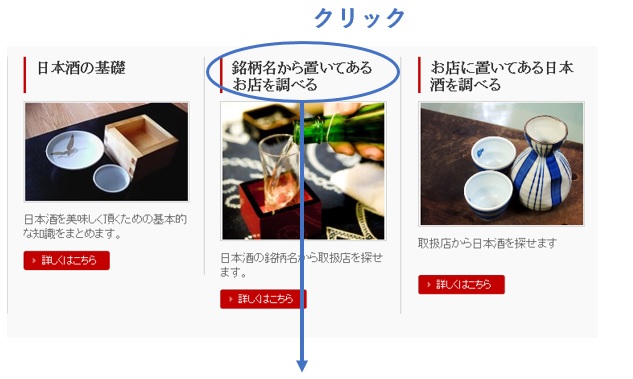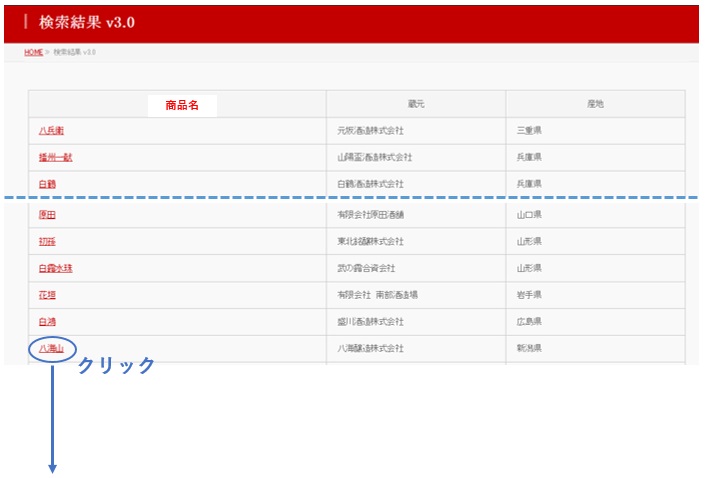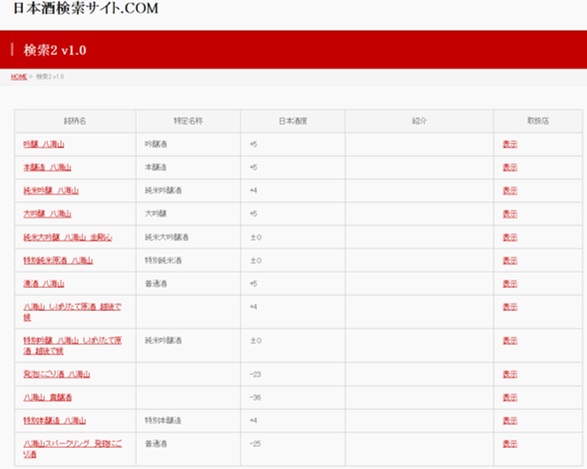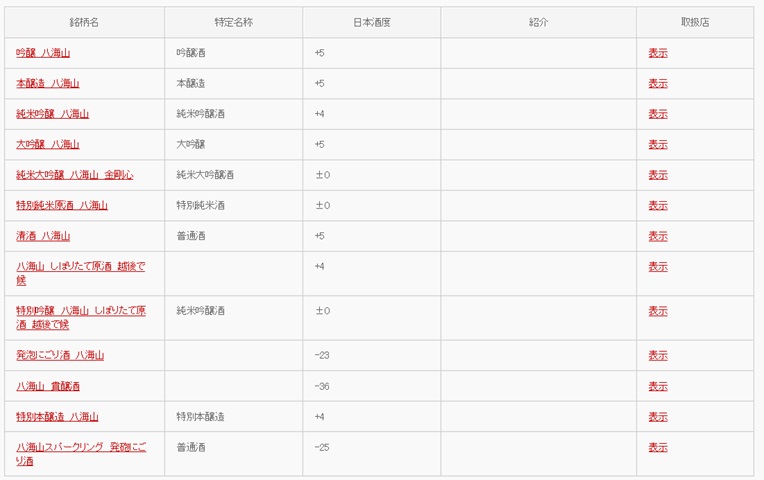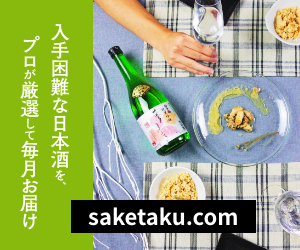- Home
- About Nihonshu, How to enjoy it
About Nihonshu, How to enjoy it
Herewith I explain how to use and see this website, while introducing what “Nihonshu” (= Japanese Sake) is, and some tips to enjoy sake.
1. To begin with, what is Sake?
If you look up “Nihonshu” in a dictionary(of Japanese), you find “alcohol drink made by Japanese unique method”. It also says “sake whose main ingredients are rice, Koji (malted rice) and water is called ‘Seishu’”.
If you only see the first meaning of “made by Japanese unique method”, shochu (spirits) or umeshu (Japanese plum liquor) can be called “Sake” as well.
However, in general, the second explanation “made with rice, Koji (malted rice) and water” is what we call “Sake”. If you ask for Sake at a liquor shop, the shop person will give you drinks made with rice, Koji and water. So, Sake usually means the second one, and this web site also use the word “Nihonshu / (Japanese Sake)” samely.
By the way, the Prof. Wikipedia’s definition in the first part starts with the second explanation, and the first one comes later.
2. How to brew Japanese Sake
As I mentioned in Chapter 1 “To begin with, what is Sake?”, Japanese sake is “alcohol drink made by Japanese unique method”. My understanding is that there are 2 meanings in “Japanese unique method”.
One is what the word “unique” means; “A method which only can be seen in Japan, not in other countries”.
Another meaning is (this is my idea) “An amazing method of Japan which other countries cannot imitate”.
Why “amazing”?
That’s because Japanese sake is made with “rice”, which doesn’t have “glucose (sugar)” in it, even though generally glucose is essential to make alcohol drinks.
Alcohol is made when bacteria dissolve glucose. Those bacteria are called “Koubo = yeast”. The yeast has so many types in all over Japan and the world, and this diversity is one of the reason of the difference of drinks between different areas in the world. Different yeast makes different alcohol.
Therefore, in general, if there is no “glucose” to dissolve, alcohol can’t be created.
A good example is wine.
Wine is made with grapes, and grapes have much more “glcose” than rice. If you taste grapes and rice, it’s obvious that grapes are sweeter because they have more glucose in them.
Yeast can work more actively when there’s much glucose. Glucose is energy for yeast, and if yeast has much energy, it can make more alcohol.
So, grapes are not so difficult to make alcohol with because they have much glucose.
On the other hand, rice which makes Japanese sake has no glucose to create alcohol.
How can it become alcoholic even though there’s no glucose?
The answer is, “Make” glucose from rice!
This is the unique and difficult part of Japanese sake’s manufacturing method to create glucose from something which doesn’t have glucose. This is why I say that it’s “amazing”.
The introduction became a bit long! I write about the steps of making Japanese sake from now.
Roughly speaking, the steps are as following;
(i) Polishing Rice → (ii) Washing Rice → (iii) Steaming → (iv) Making Koji and Shubo(starter culture) → (v)
Fermentation → (vi) Filtering → DONE☆
(i) Polishing Rice
Remove bran from brown rice to make it white rice, and polish the outer side of rice more to get the very limited part of the center which is most appropriate for Japanese sake.
The polishing ratio of rice we eat is usually around 90% (the remaining part compared to the original brown rice), and for making sake, rice is polished to under 75% in general. The outside of rice makes sake tastes bad, so this step is needed.
(ii) Washing Rice
Wash the polished rice to remove the scraped bran and other unnecessary part. After washing, rice is soaked in water to make water absorb in the rice. This part is called “Shinseki”, and how much the rice take water in here decides the taste of sake.
(iii) Steaming
After soaking in water, steam the rice in a big steaming basket.
This step is necessary for the rice’s saccharification (changing the component to glucose) which is necessary for making sake. The steamed rice becomes soft, and it gets easier for yeast to change the rice to glucose.
(iv) Making Koji and Shubo
“Koji” is malted rice made by adding Koji yeast to the steamed rice and growing it. This Koji changes the rice to glucose. Koji is the most important thing for making sake, and it works differently depends on the area, and they create various tastes. Koji is raised in a special room where the temperature and humidity are kept stable.
Another essential ingredient, “Shubo” (yeast mash) is made by mixing of Koji and water, and cultivating them in a tub in which steamed rice is also contained.
This Shubo is also grown in a special room like Koji not to get mixed with other fungus. This special room is called “Shubo Room” or “Motoba”.
(v) Fermentation
When the Koji and Shubo are raised enough, it’s ready to make it to sake.
Put steamed rice, Koji, Shubo, and water in a big tank in 3 separate times, and ferment the steamed rice to make sake. When these ingredients are put in the tank, white bubbles come out. This condition of the ingredients is called “Moromi”. Probably most of videos of making sake you see is this step. I think that you’ve seen a scene of white thing in a big container, and people stirring it with long sticks.
The white bubbles are showing that fermentation is going well, and 2 things are happening in Moromi at same time when it’s in this condition.
(1) Koji breaks down the steamed rice into glucose.
(2) Shubo breaks down glucose into sake.
Manufacturing methods of most of other alcohol drinks takes these 2 steps separately. This is “unique” point of how to make Japanese sake.
By the way, the reason why the ingredients are put in a tank in 3 times is to prevent unwanted bacteria from increasing, and also to encourage Shubo’s growth.
(vi) Filtering
When the fermentation gets enough and the brewers judge it’s “good time”, squeeze out Moromi to take out the sake liquid. This liquid still containers carbon gas and other components, and the color is gold. It becomes Japanese sake with no color after precipitation and filtering.
By the way, the squeezed solid Moromi is called “Sake Kasu”.
Japanese sake is made like this.
3. Brands of Japanese Sake
The biggest characteristic of this web site is that “you put brand names of Japanese sake then you can search restaurants which serve the brands”. So, I’d like to write about “brand” of sake here.
There should be various definition of the word, but in this web site, “brand” means “a name given to products” or “group name of sake products”.
For example, it goes like following;
As you see above, some items which have “Hakkaisan” in their names appear.
Each item has different names and different tastes, but they all have “Hakkaisan” in their names. In this way, if some different products have same names, we call the common name “brand”.
In many cases, one sake brewery (called “Kuramoto”) has one brand, and the brand names are often same as the brewery’s company name. Some breweries have different series of sake of various concepts, and in such case one brewery can have more than 2 brands.
For example, a sake brewery “Asahi Shuzo” has a brand “Kubota”. Originally, they started with a brand “Asahi Yama” which is same as the company’s name, and gradually they made various series of different concepts such as “Kubota”, “Esshu”, and “Koshino Kagiroi”.
In the data structure of this web site, the “brand” names come first, and the “label” names follow after. You can see which restaurants have which labels.
Usually, one brand has many labels, so it is rare to find a restaurant which completes all the labels of a brand. If you see somewhere like that, maybe the restaurant might be managed by a sake brewery, or the owner is really in love with the brand.
4. What is “Specific Class Name”?
If you click “Search Sake from Brand” in the top page of this web site, you see a page which shows brands and label names as the picture following;
“Specific Class Name” is words to classify the “types” of Japanese sake, and there are 8 names divided according to the sake’s “Ingredients” and “Rice polishing ratio”.
They are;
1. Honjozo Shu
2. Tokubetsu Honjozo Shu
3. Junmai Shu
4. Tokubetsu Junmai Shu
5. Ginjo Shu
6. Junmai Ginjo Shu
7. Dai Ginjo Shu
8. Junmai Dai Ginjo Shu
Usually, the bigger number is more expensive. I mean that 2 is more expensive than 1, and 3 is more than 2…… and 8 is the most expensive and good sake (it doesn’t apply to some cases). The combination of “Ingredients” and “Rice Polishing Ratio” is the reason of price difference. Let’s see about.
First of all, “Ingredients”.
If we remember the definition of “Japanese Sake” mentioned in the first chapter, you might think it’s strange to talk about “ingredients” because Japanese sake should be made with only rice, Koji, and water. Then, what kind of differences make the class names different? The types of rice? No.
It is allowed to use “jozo-alcohol (brewers alcohol)” when making Japanese sake. “Jozo-alcohol” is alcohol which can be mass-produced by machines, so the price becomes much lower compared to sake which only rice is used to take out alcohol.
Before the war, “alcohol drink” meant “Japanese Sake” in Japan. Beer was more expensive than Japanese Sake at that time.
During the war, it became difficult to procure rice for Sake. Therefore, the government allowed the breweries to mix jozo-alcohol in the rice-made Japanese Sake, and sell those drinks as “Japanese Sake”. Such Sake was called “Alu-Ten-Shu” (Jozo-alcohol added sake).
Lack of rice continued for a while after the war. In such situation, people invented “Sanbai Zojo Seishu”, “San Zo Shu” in short. This was made adding diluted jozo-alcohol, starch syrup, and chemical seasoning in “moromi” (please refer to “5. Fermentation” in Chapter 2). They could make three times as much Sake as the normal method, and that’s why it was called “Sanbai Zojo Seishu” (“Sanbai” means “three times more”). The taste was maybe something we imagine (not really good).
This “San Zo Shu” could be made a lot with less cost, so the production was kept after Japan got out from supply shortage. This is said to be one of the factor of an image of “Japanese Sake = not good taste” in Japan generally in past.
“San Zo Shu” is not made anymore now, but adding jozo-alcohol in sake is still permitted.
When we classify Japanese Sake, we see this point first. Sake made only with rice, Koji, water, no jozo-alcohol, is called “Junmai Shu”, to distinguish from ones which jozo-alcohol is mixed.
My explanation so far might make you think that “non-Junmai Shu is bad and not real Japanese Sake.”, but that is not true. In the 8 classes, 1, 2, 5, 6 contain jozo-alcohol, but these are different from “Alu-Ten-Shu” or “San Zo Shu”. These Sake contain jozo-alcohol not because the brewery wanted to cut down the cost, but to make the taste and flavor better with little jozo-alcohol. Please know that there are many Sake with jozo-alcohol which taste better than “Junmai” named Sake.
The next is “Rice Polishing Ratio”.
I mentioned that Sake with no jozo-alcohol is called “Junmai Shu”.
The ones WITH jozo-alcohol are called “Honjozo Shu”.
Japanese sake is classed into “Junmai Shu” or “Honjozo Shu” first, and under these 2 groups, there are subdivisions divided by “Rice Polishing Ratio”.
“Rice Polishing Ratio” is as mentioned in Chapter 2 “How to make Japanese Sake”; The remaining part compared to the original brown rice. In other words, “a number to express how much the rice was polished”.
In principle, polishing rice is not always necessary when making Sake, but if you don’t do it, the Sake tastes bad. The outer side of rice contains some components to make the taste bad. Polishing is to remove such part. Of course, the more you polish, the less rice become, and if there’s not much rice left, the available Sake liquid becomes less as well. At the same time, polishing more means less bad components, so if the polishing ratio is higher the taste can be better.
The rice which was polished specially for making Sake produces nice-flavored and tasty Japanese Sake after fermentation in low temperature for a long time. This method is called “Ginjo Zukuri”, and the Sake made in this way is called “Ginjo Shu”.
“Ginjo Shu” was so special until around 1950 that only some experienced “Toji” (chief Sake brewing manager) could make it, and it was rare to have chance to drink it even for Shogun or Daimyo in Edo era, or the Emperor. Now we can buy “Ginjo Shu” with affordable prices. It is surprising that the technology has developed so much.
The polishing ratio of rice decides which the sake is; “Ginjo Shu” or Not. “Ginjo Shu” is classed into “Ginjo Shu” and “Dai Ginjo Shu (Dai=big, great)”. As you can imagine, “Dai Ginjo Shu” is lower polishing ratio, which means the rice is polished more.
By the way, there are some unique or tasty Sake which are made with low polishing ratio but not with “Ginjo method”, or made by the brewery’s special technique. Let’s call such Sake “Tokubetsu (special) Shu” here.
To make it clear about “rice polishing ratio”, the ratio divides the sake into normal Sake, “Ginjo Shu”, “Dai Ginjo Shu”, and “Tokubetsu Shu”. To look back this chapter, Japanese Sake is classed into 8 types as you see the table below, including “ingredients” and “rice polishing ratio”.
| Rice Polishing Ratio, less than 70% | by special brewing method | Rice Polishing Ratio, less than 60% | Rice Polishing Ratio, less than 50% | |
| “Honjozo” | Honjozo-shu | Tokubetsu Honjozo-shu | Ginjo-shu | Daiginjo-shu |
| Junmai | Junmai-shu(※) | Tokubetsu Junmai-shu | Junmai Ginjo-shu | Junmai Daiginjo-shu |
Roughly talking, Sake is divided into 8 as above, and ones which don’t apply to anything from the 8 are called “Futsu (=normal) Shu”.
By the way, if I try to talk more accurately, I need to add the following notes;
*1 : Rice polishing ratio under 60% and non “Ginjo” method apply here.
*2 : This has to be made by “Ginjo” method.
*3 : If the ingredients satisfy the requirements, it can be called “Junmai Shu” even though the rice polishing ratio is not under 70%.
Also, to be called any names from “Specific Class Name”, the sake needs to meet other terms such as “the used rice’s grade is the third grade or higher”, or “More than 15 % of all the rice’s quantity used to make the Sake needs to be Koji”. I understand that these rules are for the restriction for the breweries, and I think for us, consumers, it is useful to know what kind of Sake it is but we don’t have to think about such things too much. By the way, this “Specific Class Name” is established by Japanese National Tax Administration Agency, and you can check it on its web site.
5. What is “Nihonshu-Do”?
This web site shows each item’s data.
As far as I know, Japanese Sake is the only alcohol drink which is metered in such numerical measures (I have not seen that of wine).
Japanese sake has various numerical values to express the taste. In those values, “Nihonshu-Do (Sake meter value)” is most used. Many Sake breweries introduce their products’ Nihonshu-Do in their web sites.
Now, what is “Nihonshu-Do”?
In general, this is used to signify if the sake is Amakuchi = sweet, or Karakuchi = dry. The bigger number is “dry”, and smaller is “sweet”.
For example, let’s see “Shochikubai Shirakabegura ‘Mio’ Sparkling Seishu” made by Takara Shuzo. You can see this data in the database here, and the Nihonshu-Do of “Mio” is minus 70. If you try it, you can see that it’s very sweet.
On the other hand, what “Karakuchi = dry” Sake is like?
My understanding is that whether the Sake is dry or not depends on the person. For example, one of the famous “dry” Sake is “Kudoki Jozu Bakuren Ginjo Shu Super Dry” made by Kamenoi Shuzo.
If you hear a word “Karakuchi”, first we, Japanese, imagine tongue-numbing spicy taste such as “hot spicy curry”. In case of Japanese Sake, of course, “Karakuchi” means differently from curry’s (cooked rice never become spicy, does it?). There is a brand of beer whose name includes “Super Dry”, but you know that it doesn’t mean spicy beer even though it’s “dry”. So, “Karakuchi = dry” means “not sweet” for alcohol drinks.
“Nihonshu-Do” shows the alcohol weight compared to the same amount of water.
If the alcohol weight is same as water, the Nihonshu-Do is 0, and it’s shown as following;
Lighter than water => + Nihonshu-Do
Heavier than water => -/- Nihonshu-Do
As I mentioned in Chapter 2 “How to make Japanese Sake”, Koji changes glucose to alcohol, so Japanese Sake contains both alcohol and glucose.
Alcohol is lighter than water, so when alcohol’s proportion is higher the Sake becomes lighter than water of same amount, and when alcohol is less (means more glucose), the Sake becomes heavier than water.
In the Sake liquid, if alcohol’s ratio is higher, glucose relatively becomes less, and the opposite can be said.
As you can imagine, if the Sake’s alcohol proportion is higher and glucose is lower, the sake becomes “strong alcohol taste, less sweetness”.
On the other hand, if alcohol is less and glucose is more, the sake becomes “less alcohol taste, more sweetness”.
Nihonshu-Do and taste have the following relation
High Nihonshu-do = More alcohol = Less glucose = Not sweet = Karakuchi (Dry)
Low Nihonshu-Do = Less alcohol = more glucose = Sweet = Amakuchi (Sweet)
In short, “High Nihonshu-Do is dry” and “Low Nihonshu-Do is sweet”.
“Nihonshu-Do” works to know whether the sake is sweet or dry, but actually, Japanese Sake is a type of “Jozo Shu (fermented alcohol)” not like Shochu or whisky. Jozo Shu contains various components other than alcohol and glucose, and the combination of all components decides the taste. Therefore, if you want to express sweet or dry very accurately, there is another measure called “Amakara-Do”. However, this is not really used, and “Nihonshu-Do” and “sweet/dry” match almost every time, so I think that it can be said that “Nihonshu-Do” is useful enough. In real, as I already mentioned, sweet or dry depends on the person who tasted it or the components contained in the Sake. Especially in case of “Ginjo Shu” and “Dai Ginjo Shu”, it often happens that some Sake tastes sweet even though the “Nihonshu-Do” is high.
REFERENCE:
Wikipedia, the free encyclopedia Japanese version, “Nihonshu”, December18th,2016. 2:55
Atsuko Yamamukai, Mezase! Nihonshu no Tatsujin – Shinjidai no Aji to Deau-, Chikuma Shobo
Tetsu Kariya and Akira Hanasaki, Oishimbo, Shogakukan


